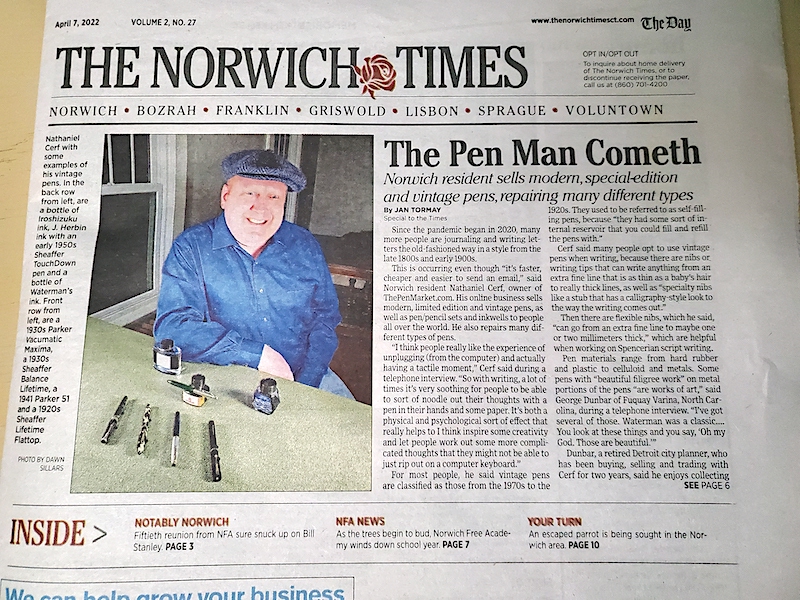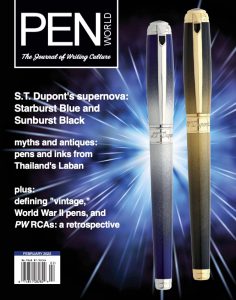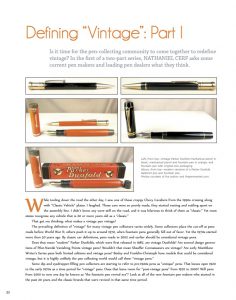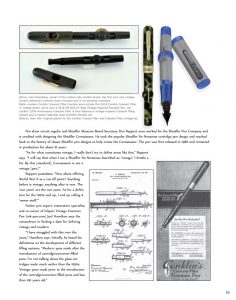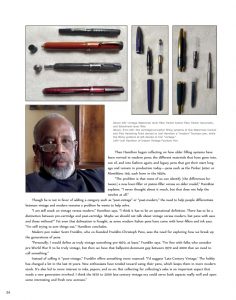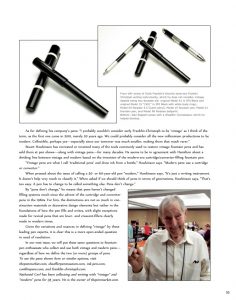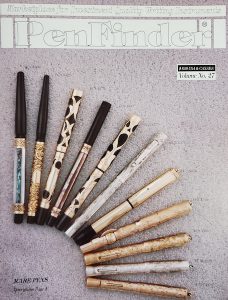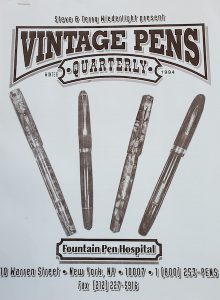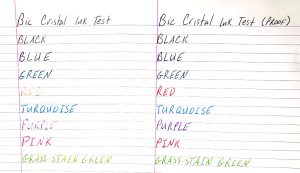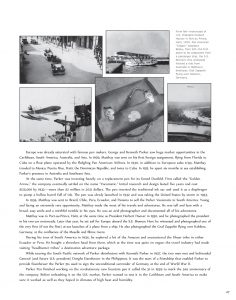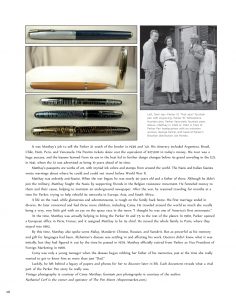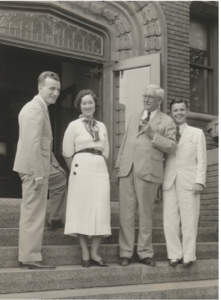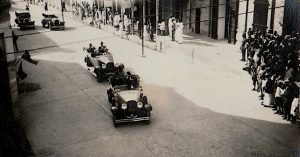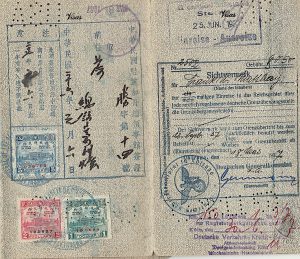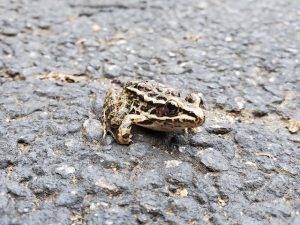News about ThePenMarket.com is spreading. I was lucky enough to be honored by a front-page feature in The Norwich Times! We’ve been featured before in “Pen World” magazine. However, I think this is our first time in a newspaper. Check it out: https://www.theday.com/local-news/20220406/norwich-resident-specializes-in-modern-vintage-pens

Tag Archives: #vintagepens
Pen World: Defining Vintage Part 1
Just what is it that makes a pen vintage? Many people are asking that question these days. As time advances, are the old definitions of “vintage” and “modern” really holding up? My article in Pen World Magazine is the first of a two part series. In Part 1, I put the question to 4 legendary experts who helped to build the pen collecting hobby into what it is today. In part 2, I will put the same questions to a new generation of collectors and users. Yet, for now, here is Part 1, reprinted here with permission from Nicky Pessaroff, editor of Pen World Magazine.
To better read each page, click the individual images.
Pen Collecting Time Capsule
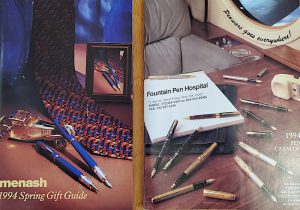
Here are two 5″ X 7″ pen catalogs from 1994! I was intrigued by the Menash catalog as I don’t know what became of that company.
Leaving the pen-collecting life behind, a friend of mine has given me his stash of catalogs and advertising from 1992 through 1994. Its contents blew my mind.
Most of the material was from 1994, the spring I graduated high school. While it is difficult for me to comprehend that was 27 years ago, what is harder to comprehend was how big pen collecting was becoming that long ago!
I found my first fountain pen in 1985 when I was 9 and adored it. It belonged to my late grandfather, and it still worked: a 1928 Sheaffer Lifetime Balance. I used it until it finally broke down, and I became obsessed with finding other fountain pens. They just didn’t exist. Not in my 10-year-old world or the various circles I moved in. I asked adults for them, and all the adults laughed and said they threw their fountain pens out years ago because ballpoints were “so much better.” Even then, I knew that was heresy.
Sheaffer sent me an Imperial to replace my grandfather’s pen, which they could no longer fix. I snatched up those terrible Sheaffer Student Pens at the grocery store. Yet, I was the only person of any age I knew who loved fountain pens. Studying German while in a San Diego high school, my teacher told us that most German kids and adults still preferred using fountain pens. San Diego had no pen stores that I knew of, and the internet did not exist. I worked a part-time job and saved most of my money to pay for my trip as an exchange student to Germany. Most of my fellow American exchange students saved up their money so they could drink heavily in a nation where the drinking age was 16. I begged my German family to be taken to a proper stationary shop. I gleefully purchased a stub-nibbed elegant black Rotring and a bottle of Pelikan royal blue ink. I wrote with that poor beast until its threads wore off. It wasn’t until the internet got more advanced that I could search for fountain pens and finally start finding them in about 2005.
And sooo, it surprises me now to see that while I was searching the world over for fountain pens, there was a ground swell of people who did still love fountain pens…and vintage pens, at that! Plus, many of the people I know on the pen show circuit were innovators of the vintage pen revival.
For example, when I first met Glen Bowen, I did not know he founded “Pen World” magazine. He had already sold his stake in it, but his wife Susan was still the circulation director at Pen World. She and I bonded over the fact she went to journalism school at Northwestern with my father. When she later introduced me to Glen, I thought he was just a pen newbie helping his wife at the Pen World table. Ooops!
In this stack of publications is a protean “Pen World” magazine catalog he published in 1992 called the “Pen Finder.” It was printed at the same time as the early “Pen Worlds” but was a catalog of vintage pens he restored that collectors could buy. You had to subscribe to it. There were simply several glossy photos of capped fountain pens and some inner pages that served as an index of what the pens were and how much they cost. No nib photos. As people didn’t yet know the history of the pens as well then as they do now, I think I even spotted a few pens with mismatched caps and barrels.
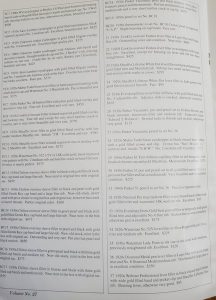
The catalog index of pens for sale in “Pen Finder.” Back then it was too expensive to print color on every page of a magazine. As such there would be color pages and B&W pages.
Without the internet, vintage pen research was a slow and ongoing process. So many of those early collectors had to do their own research into the histories of pens. And much of that was very hit and miss. The internet really made it easier for everyone to get together and compare notes and research.
I love the low-tech feel of these publications. The world-famous Fountain Pen Hospital vintage pen catalog was just a photo-copier copy of pens and prices. Bexley Pens advertised new models with a beautiful glossy photo paired with a home-printer list of features and benefits.
The more professional catalogs for new merchandise were more sophisticated, but I sure as hell wish I could get my hands on some of this Montblanc and Omas at their original pricing. Brand-new, factory-fresh Montblanc 164 Classique models for $99. Omas fountain pens for $325 to $100! FPH was selling a stash of 14k gold #5 Waterman MUSIC NIBS for $50 a piece!
Vintage pen prices were all over the map. There were rare pens for $100 or $200. Really common pens for up to $800. And, yet, other pen prices haven’t changed. Standard Parker Vacumatics went for around $125.
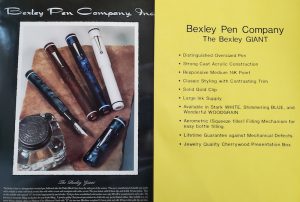
Ads for the Bexley Giant. Note the glossy one-page sheet paired with a home-printer fact sheet. That was not unusual advertising back then. It was fairly slick and affordable.
When I finally got some guidance from my buddy Hans who taught me about vintage pens and how to repair them in 2005, I felt like we were the last two people on earth who loved old fountain pens. With his instructions, I felt as if I was somehow reinventing the wheel or reviving a long dead religion. Yet, this is evidence I was never truly alone back then. I was just searching in all the wrong ways and places.
It is easy to be glib and say, “Oh, gee, I wish I knew in 1994 what I know now.” While that wouldn’t be untrue, I really wish I knew my pen tribe then and could take the journey with them to where we are today. Fountain pens have always brought me joy, and they clearly bring many other people joy. And while I am very happy we have found each other in this grand and glorious age of the internet, it would have been nice to have learned and shared at an even earlier age.
Bic Cristal Inks Get Testing

We tested these 8 Bic Cristal pens to see how ballpoint ink holds up to 6 months of sunlight. Blue, Pink, Green, Black, Grass-Stain Green, Purple, Turquoise and Red.
During my last visit with Ink-Fast Donn at the D.C. Pen Show in 2019, he said he was starting to test ballpoint inks to see how well they hold up to UV light.
Last summer, I discovered a collection of the famous and commonly used Bic Cristal ballpoints in my fencing gear. I taught a wonderful group of teens and tweens advanced competition maneuvers and strategy, and to help them remember their lessons and opponents, I insisted they keep “Diaries of Doom” and “Tomes of Terror.” To help personalize it more, I handed out colorful notebooks and pens.
Armed with 8 colors (blue, pink, green, grass-stain green, black, turquoise, purple and red), I created a sample on Rhodia paper and taped it to a sunny window of my home at the end of August. I took it down at the end of February and was surprised by the results.
This photo doesn’t really do full justice to the sample set and proof set. The blue doesn’t look as blue as it does in real life.
Surprise #1 to me was that the black ink faded. With fountain pen inks, you can generally count on black to be the most stable and fade-proof. While it didn’t fade away entirely, it had issues.
Surprise #2: Blue! Blue fountain pen inks fade something fierce under the withering sun. Bic Cristal blue got stronger! It lost some of its blueness and turned blacker, but it held on defiantly under the sun’s gaze.
Surprise #3: Grass-Stain Green didn’t fade as much as I thought it would. It faded a little.
Red and purple faded the most. Green, turquoise and pink faded a little, but survived okay.
Reflecting on this experiment, for some reason, I always assumed oil-based ballpoint inks would be far more permanent than water-based fountain pen inks. Yet, their chemical compositions all have their frailties. Some ballpoint colors react differently than fountain pen inks, but that shouldn’t surprise me as much as it did.
Our Latest Story in ‘Pen World’
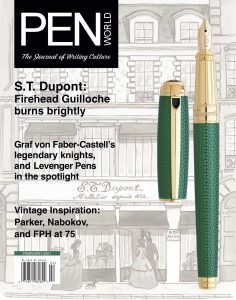
I wrote a story featured in the February 2021 issue of Pen World Magazine. We have been given permission to reprint it here.
Check out the February 2021 issue of ‘Pen World’ Magazine! They loved our blog post about Parker’s Vice President of Foreign Sales Frank Matthay and asked us to write a more pen-centric story about Frank and Parker! Editor in Chief Nicky Pessaroff has given me permission to reprint and post the magazine cover and story here for your entertainment. It is different than the original blog post, and I hope you enjoy this new story. Also be sure to run out and subscribe “Pen World.”
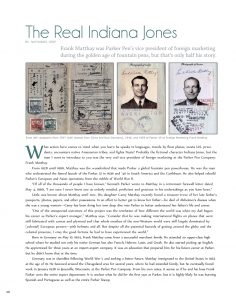
Pen World Magazine has given us permission to reprint this story I wrote for the February 2021 issue. Click the image to see a larger, more readable, version.
Decameron 2020: The Price of Guilt
The Price of Guilt
By Art Cerf

Here’s the first snowfall of the year in Connecticut. It has nothing to do with the story. We just think it is beautiful and as good a way to illustrate this story as any.
Mike and Jill had been married for almost two years and still behaved like newlyweds. They treasured each other.
One morning Jill woke up with a headache and a slight fever. She said it’s just a cold and went on with her day. But the headache got worse and her fever climbed so Mike rushed her to the hospital. It was the last time he would see her for four weeks.
He checked about every four hours with the hospital staff but she was showing no improvement. In fact, three days in the doctors said they had to put a tube down her throat because her oxygen levels had dipped so.
Mike was worried sick. He couldn’t work. He couldn’t read or watch TV. About all he could do was go outside and walk…and walk…and walk.
One day, he ran into Maggie, one of Jill’s acquaintances and she asked for Jill and he told her how she was now hospitalized with Covid. She looked at him…gaunt in appearance, he hadn’t shaved in days nor eaten much.
She said let’s go back to your place and I’d cook you up something. He followed her and she rummaged through the fridge and came up with bacon and eggs.
She told him to go upstairs, shower, shave and change his clothes. When he returned, he suddenly realized he was ravenous and quickly ate every bite.
After the meal, he asked her if she’d like a beer.
“No, but if you have any gin, I’d take a martini.”
So they both had martinis and talked. And then a second martini and then a third.
The next thing he knew, he was getting out of bed to pee while nursing a terrible hangover.
As he returned, he saw a sleeping Maggie, one bare breast peeking out from beneath the sheets.
He tried to dress quietly but she awoke smiling, saying, “Good morning, lover.”
Mike turned scarlet and stammered, “We shouldn’t have, I shouldn’t have…”
She stopped him, saying not to worry, it was a one-time thing and she had no desire to break up his marriage, adding, “As for me, I really enjoyed myself and apparently, you did too…twice!”
Maggie then said she’d take a quick shower and be on her way.
Those were the longest 25 minutes in Mike’s life until she went out the door.
Then he worried, “What if the neighbors saw? What if she had a social disease or, God forbid, Aids?”
And then he realized he had used no protection…what if she’s pregnant?
Just then the phone rang and it was the hospital. A doctor told him Jill had been taken off the ventilator and was doing much better and though still very weak, could go home in two or three days.
Mike ran upstairs, stripped the bed and washed the sheets…twice. He then scrubbed out the tub to make sure none of Maggie’s long, chestnut hair was stuck in the drain or anywhere else. Then he cleaned up the kitchen, washing pots and dishes, again trying to erase any sign of Maggie’s presence.
Three days later, Jill came home and went straight up to the bedroom to lie down.
Then the phone rang and it was Maggie.
“Mike,” she said, “I had a Covid test at work after our night, and I’ve tested positive but asymptotic. However, they warn that I may have past the virus to anyone I’d seen or spent time with.”
A Very Parker Thanksgiving
Thanksgiving hasn’t been this chaotic and stressful for everyone in America since at least World War II…possibly since the 1919 Spanish Influenza pandemic. There’s the Covid-19 pandemic, political turmoil, recession, open-rampant-growing racism, civil unrest and climate disaster for many recovering from wildfires and hurricanes.
It feels more important than ever to take a day to recognize all of the things we are grateful for in our lives. Me, I’m thankful for my fiancé, her mother and I all being healthy and well together in our new home. I’m thankful my parents, sister and her family are healthy and safe. And I’m thankful for all of my friends, whether we know each other from before ThePenMarket.com or because of it.
So many customers became friends who beautifully color my life. In Chicago, I have a Civil-War studying, vintage-camera-loving buddy with fantastic wit and a social-working, philosophizing friend who convinced me to not give up on my novel. There’s the salsa-dancing police detective who specializes in tracking down child abusers in Arizona. A Heinlein-loving pen collector in Virginia. A virologist who is working on the Covid-19 vaccine. A certain retired urologist in Connecticut. A retired sailor in Virginia Beach. A school teacher in Germany. A Waterman-loving Oklahoman. The nursing home nurse in Texas. Several great paramedics in Washington and Colorado. I have a 3-fingered brother from another mother down in Texas, as well as a wonderful roommate and travel buddy who loves cars as much as pens. I’d have never guessed I’d have as many additional new and wonderful friends from the Deep South as I do. I am a Yankee city boy, after all. And, of course, there are many, many other pen friends whom I delight in getting to know through the site.
The newest friend I think you’ll enjoy meeting is Camy Matthay. Camy reached out to me after reading my series of stories about the pens that ended World War II. Most of those pens were Parker pens, and she is reconnecting with her late father by doing the deepest dive into Parker pens I’ve seen in years.
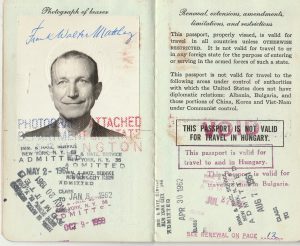
Frank Matthay in his passport issued 1959. Matthay was the leader of Parker exports from 1928 through 1966.
Who was her father? No. Not George or Kenneth Parker. Her father was the unassuming sounding Frank Matthay…the man responsible for making Parker a global brand!
Her story is equally captivating as her father’s. Camy came along late in Frank’s life. And, unfortunately, he died of early-onset Alzheimer’s in the mid-1970s when she was a teen. His memories were robbed of him by the disease, just as she was coming of age and really interested in getting to know her father as a person more than just Dad. Life moves quickly in one’s teens and twenties, and a little later in adulthood Camy decided to reconnect with her late father when she uncovered a treasure trove of boxes filled with his papers, passports, photos and other personal effects.
Frank, as it turns out, lived the adventure of a lifetime. Not only did he live well at a time when most of the world lived in crushing poverty, he saw the world before it lost much of its mystery. He met presidents and Nazis—generals and actual Amazonian headhunters. He helped give birth to the Parker Vacumatic, 51, 61 and 75!
Thankfully, Camy has shared her discoveries with me and is happy to share them with you, too. The following is my summary of her father’s biography with her full approval.
Frank Matthay was born May 10, 1904, in Beyenberg, Germany. Too young to fight in World War I, he was a talented student in what now would be considered a college-prep high school. Here he specialized in studying the classics, including the languages Latin, Greek, Hebrew, French and his native German. Along the line, he also picked up English.
At the tender age of 19, he immigrated to the United States in 1923. He was sponsored by his uncle. Germany, at the time, was struggling desperately with the national economic collapse of post-WWI reparations and more. He moved to Chicago, where he was supposed to work in his uncle’s grocery store. However, it seems he never worked for his uncle, taking a job initially as a soda jerk and taking night classes at a YMCA.
It is unclear when and where he mastered English, as well as Spanish, Portuguese and some Mandarin Chinese. Yet, his early training in the German school system likely made it very easy for him to learn any other language put in front of him.
Also unclear is how he joined the Parker Pen Company in January 1928, at the age of 23. His mastery of languages was what got him a job in the export department, and he was soon working closely with George and Kenneth Parker.
By all accounts, Frank was the life of any party with a natural gift of gab and always armed with a joke and amusing stories. He was tall and lean with a broad, easy smile and a glimmer of mirth in his eyes, plus he had a meticulously Teutonic attention to detail. All important traits for setting up a global distribution and sales network in Central America, South America, Europe, Asia and South Africa!
After a year with the company, Frank was sent on his first assignment to Cuba on the two-year-old airline known as PanAmerican. His career would actually parallel the rise of PanAm. He rode on every glamorous (and not-so-glamorous) float plane they had including the very early Sikorsky S-38, Consolidated Commodore and the extremely lux Sikorsky S-40 “Caribbean Clipper,” which was the first of PanAm’s famous “Clipper” airliners.
On the success of his Cuba trip, in 1930 he was sent to Cuba, Haiti, the Dominican Republic, Puerto Rico, Germany, Denmark, Sweden, Switzerland, Italy, France, Mexico and Cuba, once again. During his trip to Europe on the SS Bremen, he witnessed one of the first, if not the first, aircraft launched from a ship at sea. It was a mail plane launched from a catapult to speed the delivery of the mail the ship was carrying. In 1931, he spent 6 months “on the road” building Parker’s network in Australia and Southeast Asia!
An avid photographer, Frank took pictures of all of his travels. He has images of President Herbert Hoover’s 2-car motorcade in Port au Prince, Haiti. He loved exploring volcanos. On one of his trips to Peru or Ecuador he met and photographed a tribe of headhunters. He even bought a shrunken head from them for $25 (about $330 in our current money). The images look as if they could have been in National Geographic.
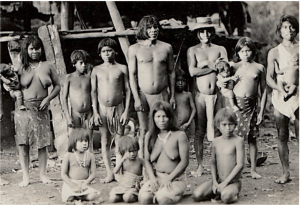
Frank took this photo of a tribe of headhunters in Peru or Ecuador. He bought a shrunken head from them for $25.
If you remember my stories about Kenneth Parker befriending Gen. Dwight Eisenhower in the Philippines, Frank was with them!
Fans of the Parker 51 will love knowing that Frank was the architect of the 1939 and ’40 release of the preliminary Parker 51s in South America and the Caribbean! His itinerary in 1939 was packed with extended trips south of the border. His itinerary on PanAmerican Airlines alone cost nearly $27,000 in today’s money. That doesn’t count his hotels, meals, etc. Yet, it also laid the ground work for the sale of tens of millions of Parker 51s both abroad and at home.

Here is Frank’s copy of the PanAm route map from 1931. Odds are really good that he flew every leg of that route.
Financially speaking, Frank was very well paid for his efforts. At the end of the Great Depression in 1939, he was making $5,000 a year. That is just shy of $100,000 a year in today’s money. And that doesn’t count for his luxury travel and adventures paid for by the company. According to records from Janesville that Camy found, he was making more than local doctors. Parker’s famous nib grinders of 1939 made $2,400 a year. A typist at Parker would make $1,000 a year. (Other cool details she uncovered.)
Frank’s passports are works of art, colorfully illustrated with visas to scores of nations. More impressive than the stamps of many colors are the notes from customs officials. Chilling are the notes by Nazis and Italian fascists telling him where he can and cannot go. It also seemed to him at times that the Nazis had him under surveillance. As a former German citizen who became a naturalized American, he was suspicious to them.
As it turns out, they had good reasons to suspect him. He was very anti-fascism. After the outbreak of World War II, he worked with friends and family in Belgium to funnel money to the resistance fighting Nazi-occupation.
His post-war years were just as busy, as he rebuilt Parker’s global networks from the rubble of Europe’s and much of Asia’s destruction.
Unfortunately, a life of travel and corporate empire building was rough at home. His first marriage, in which he had 3 children, ended in divorce. Later in life he remarried and had three more children, including Camy. Yet, that was difficult, too. He traveled around the world so much, a very, very young Camy thought he was one of America’s first astronauts for a little while.
In 1960, Parker opened a sales office in Paris, and Frank and his family were moved there to run the office until 1962.
By the mid-1960s, Frank’s memory started to fail. Very little was known about neurological diseases such as Alzheimers back then, and doctors actually thought his medical problems stemmed from diseases he might have picked up on his travels or from eating exotic native foods, such as, apparently, a still beating snake heart in Vietnam.
Frank retired as a vice president at Parker in 1966, after 38 years of dedicated service. He continued his hobby of collecting stamps and learning Russian and Sandskrit until his Alzheimers made it impossible. He passed away in 1974.
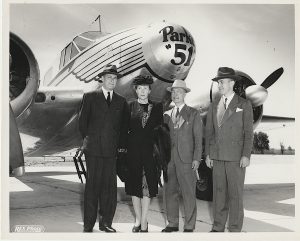
Frank is on the far right posing with the famed Parker 51 airplane. Among his many other hobbies, Frank was a licensed pilot, though I do not know if he flew the “51.”
Honestly, there are so many more adventures in Frank’s life, but I just couldn’t fit them all into this post without simply writing a book. I am so thankful for Camy’s reaching out to me and sharing her stories and research. I hope you enjoy learning a little more about Parker’s international growth and its star salesman and leader.
Have a wonderful Thanksgiving and holiday season. No matter how bad this pandemic gets, remember we are going to get through it. A vaccine is on its way. And one day, this pandemic will be nothing more than a bad memory. Thank you for visiting and supporting ThePenMarket.com. We can’t do it without you, and we are so grateful for you. Stay strong and keep writing.
Decameron 2020: Where did Janey Go?

There are so many beautiful scenes to photograph in Connecticut in the fall…especially a stone wall leading to oblivion.
“Wheee!,” cheered Jane, clapping her hands for encouragement. “Look at that little girl run.”
Vick looked up from the papers he was grading and smiled at his mother-in-law. “She’s adorable.”
There was nobody else in the living room.
Since before they moved into this fully restored, 3-story Queen Anne home in New Haven, Jane had been seeing people who just weren’t there.
Jane had early onset Alzheimer’s and was nearing the end of the line. This little girl she had been seeing since they moved into the house likely was a series of happy memories about Vick’s wife when she was a little girl.
Jane was happy and comfortable, and that was all that mattered to Vick.
Getting this tenured professorship at an Ivy League school was a dream come true for Vick. His wife Sue was an architect who was in high demand, and she could usually work from home, traveling when she needed to. She was 100% supportive of this move, and they both agreed their newly renovated home was the best home in which either had ever lived.
They took great care with the interior design. Each room was unique, creating its own ambiance. The living room was tastefully elegant in a rich 1890s Victorian motif to restore the home to some of its original state. Dark woods, red cushions and wall coverings. House plants helped fill the room with life. Ferns and vines threatened to overtake the windows and furniture. The walls had paintings or bookshelves tastefully arranged. It was Vick’s favorite room.
Sue came in and asked, “You didn’t happen to take a bath and forget to empty the tub, did you? There are watery footprints all over the floor.”
Vick gave a subtle head shake no, and they both looked to Jane, who was bare-footed, and playing patty cake by herself and giggling.
Sue sighed, “I’ll go drain the tub and clean up the floor.”
“That’s alright. I can do it,” Vick offered.
“No, you’re busy. I got it.”
Keeping tabs on Jane was easily a 2-person job. Jane always meant well, but she had virtually no short-term memory. Frequently, she’d wander off and do household chores or yard work. It sounded great on the surface…until they discovered she never used dish soap and stacked wet, dirty dishes in the cabinets, without any regard for the contents of the cabinets and drawers in which she placed them. The pantry was forever being reorganized.
It was easier when their kids were home, but their two girls were off at college. For now, Vick and Sue tag-teamed watching Jane or cleaning up after her. The hardest part was that Jane preferred to be busy. You couldn’t just plunk her in front of a T.V. Jane preferred mowing, raking or pruning to watching T.V. Yet, to set her loose on her own would be trouble. When they gave her a trowel to weed the garden and left her alone, she forgot to weed and dug a 4-foot deep hole instead.
Neither Vick nor Sue blamed Jane. It was the disease.
During the week, a caretaker came to look after Jane. On the weekends, it was just Vick and Sue. They didn’t mind. They had set some boundaries for defining the moment they would need to find a nursing home, but they enjoyed Jane’s company and knew how much she’d hate a nursing home in her present state of mind.
They were content to give Jane as many good years, months or days as they could in their happy home.
•••
The advantage to having kids off at college was sleeping in on Sundays and rediscovering each other.
Sue and Vick were as flirty as teenagers while making pancakes and bacon in the kitchen. Vick was nibbling Sue’s ear when Jane rushed in, out of breath and wearing nothing but a bathrobe.
“Have you seen that little girl?” she asked. “I tried to chase her, but she’s faster than me.”
“No,” Sue said, putting down the mixing bowl full of batter that she was stirring. “You want some breakfast? I’ve got some strawberries and whip cream for your pancakes. I know you like that.”
Jane looked confused. “Not right now. I really need to find that little girl.”
Jane left the kitchen on her quest, and Sue sighed and shrugged. “I guess playtime is over, now that she’s up.”
Vick gave her a kiss. “To be continued.”
She gave him her naughtiest smile, then Jane came running back into the kitchen.
Jane was pale and trembling. Panic was in her eyes.
“There’s a man in the house,” she said.
“What?” Vick asked. “Where?”
“I don’t like him,” Jane’s voice was a tremor. “Make him go away.”
“It’s okay,” Sue soothed, as she embraced her mother.
“What did he look like? Where is he?” Vick questioned, grabbing a long, sharp kitchen knife.
Vick was a pudgy college professor, not a knife fighter, but he figured something was better than nothing.
Jane was at a loss for words and just pointed out the kitchen entrance she came in.
“Be careful,” Sue cautioned.
Searching the first floor, Vick saw no trace of anybody. No broken windows. No disturbed furniture. No stolen items.
He was surprised to find the front door unlocked. Opening the front door, a package was waiting for his wife on the porch.
Snorting a small laugh, he put together the pieces of the puzzle.
He took the package back to Sue and asked Jane, “Did you see the delivery man? Is that who scared you?”
“What man?” Jane asked, confused.
Sue exhaled in relief.
“I’ll check the rest of the house,” Vick said. “But, I think we found our culprit.”
“Thanks,” Sue agreed, as she took the package.
Nothing was amiss as Vick explored from low to high. The only thing out of place was that the 2nd floor bath tub was full, again. Muttering to himself, Vick drained the tub and sopped up the mess on the floor with a towel.
•••
Raking the last of the front yard leaves into a huge three-foot pile, Sue and Jane were dressed in gloves and heavy sweaters.
It was a crisp, late-October day.
“Watch that little girl play in the leaves,” Jane said, resting on her rake.
“I don’t know about any little girl,” Sue smiled mischievously. “I think you want to play in the leaves.”
“Noooo,” Jane protested. “I’m too old. What will the neighbors say?”
“They’ll say, ‘Look at the old lady having fun. Maybe she’ll let me play, too.’ Go on. Have fun.”
Jane jumped into the leaves with reckless abandon. Sue picked up a pile of leaves and dropped them on her. Then she fell into the leaves next to her mother.
They both laughed like they did when Sue was a little girl.
When they tired of laughing and throwing leaves at one another, they lay quietly staring at the cold, grey sky through the nearly naked branches of an old oak tree.
“I don’t think I’ve got another winter left in me, Sue.”
Sue was shocked by the sudden return of dementia-free clarity.
“Of course you do, Mom. You’re a skiier.”
“Not any more.” Jane was silent a moment before continuing. “I really want to thank you and Vick for how well you are taking care of me, but I want you to know that it is okay…whatever it is you need to do to take care of me.”
Tears welled in Sue’s eyes, as she took in the full permission of what her mother was granting her.
“I love you, Susie.”
“I love you, too, Mama,” Sue said, hugging her tightly and crying. “I miss you so much.”
They cried and hugged some more, and before either of them was ready, the dementia returned.
“Why are you crying?” Jane innocently asked, oblivious to her own cheeks wet with tears.
Sue tried hard to compose herself quickly. “Nothing. Nothing, Mama. How about some hot cocoa?”
“Only if my little friend here can have a cup, too,” she said, climbing out of the leaves and on to her feet.
“Of course,” she agreed, absently wiping her nose on her sleeve.
•••
Later that night, just down the hall from her loving daughter and son-in-law, comfy and warm in her bed, Jane passed away peacefully.
On October 30th, a small grave-side service was held for Jane. Her granddaughters came in from their respective colleges. Nobody in New Haven knew Jane, but a couple of Sue and Vick’s colleagues came to offer their support. The girls were upset. Sue and Vick had far more complex feelings. They were sorrowful for Jane’s passing. She died too young from a disease that deprived her of her memories and personality. Yet, being her constant caretakers had taken a toll on them, too, and they felt guilty for feeling some relief.
At midnight Vick was awakened by a small hand gently patting his shoulder. He groggily thought it was one of his daughters, momentarily forgetting they were now grown women.
Through his bleary eyes he saw a 9-year-old girl patiently standing next to his bed. She had curly hair like Shirley Temple and was wearing a 1940s’ dungaree jumper.
Coming to his senses, he gasped and sat up in bed—scooting backward until his back was against the headboard.
“Who are you?”
Sensing his fear, the little girl took a step backward and asked, “Where did Janey go? I haven’t seen her for a couple of days.”
Sue started to stir next to him.
“What?” Vick asked. “How did you get in here?”
The girl smiled like he was being silly.
“You know me,” she explained. “I’m Janey’s friend. You called me adorable once when we were playing in the drawing room.”
Sue was coming to her senses and trying to understand what a little girl was doing in their bedroom.
Vick tried to explain gently to someone whom he wasn’t sure existed, “Umm. Jane died several days ago.”
She looked at him quizzically, as if she didn’t quite understand.
Then a soft familiar voice playfully called from down the hall.
“Evvvvelynnnn. Come out, come out wherever you are.”
“Mama?” Sue whispered, confused.
“Oh! There she is,” said the little girl, perking up. Then her eyes widened and fear shown on her face. “I forgot to warn her about the man with the bloody arms in the bathtub!”
The girl faded away as she looked like she was going to run out of the room.
Seconds later Jane screamed from the middle of the hallway.
“Mama!” Sue shouted, as she and Vick ran down the hall to the bathroom. Moments later they were joined by their daughters.
They stood silently watching the lit bathroom. Nobody else was in the hall or bathroom, but the tub was full and wet footprints led to the hallway and vanished.
HAPPY HALLOWEEN
Decameron 2020: The Pickerel Witch
Ilke and Streusel were walking through Germany’s dark, primeval Black Forest. They had been lost and wandering for days.
“Ilke,” her little brother called. “I’m hungry. Why did our evil step-mother send us on this horrible quest to find dingleberries in the forest?”
“I don’t know,” she replied. “But even if we find this dingleberry bush, I do not think we can find our way back to our loving-but-easily-duped father and have a dingleberry pie.”
They trudged on, weak and trembling.
“Remember our friends, Hansel and Gretel?” Streusel asked.
“Of course.”
“Well, just last week I heard that they found a cabin made of candy,” he said. “Maybe it is still here somewhere close to us.”
“I hope not,” Ilke shivered. “I heard they met a witch who tried to eat them.”
“Yeah, but they pushed her into an oven and killed her. That means there should be plenty of fresh candy waiting for us.”
“I think we’d be better off avoiding witches.”
Eventually they came to a swampy clearing. They rested their weary little bottoms on a log.
“I’m so hungry,” Streusel exclaimed. “I could eat a frog.”
Just like that a splotchy, warty Pickerel frog hopped up between them on the log.
With the last of his strength, Streusel caught the frog and held it gently in his hands as he contemplated eating it raw.
“Don’t hurt it,” Ilke commanded. “It never did anything to you. You have no right to take its life.”
Streusel cried with guilt for ever thinking of killing a living creature, and he cried because he was hungry. He carefully set the plump little amphibian down.
It looked at him and ribbeted, “Thanks.” Next there was a flash and poof.
The children screamed as a beautiful woman with thick, shoulder-length blonde hair appeared wearing a long, black dress, black hobnail boots and a wide-brimmed black pointy hat.
She produced a compact from her black-satin dress and powdered her nose. Then she gave a toss of her golden locks, just for effect before closing her compact.
“Hi there,” she greeted the children. “My name is Madison, but you can call me Maddie.”
The children looked at her and trembled in terror.
“Oh, you little lambs must be starving,” she said and handed each child a peanut butter and jelly sandwich with the crusts cut off, just they way they liked.
“Our step-mother says never to take food from strangers,” Ilke declared.
In a sweet and sardonic voice, Maddie asked, “The same step-mother who intentionally left you in the forest to die so she could have lots of sex with your dim-witted father and raise her spawn in your place?”
“Ohhhh,” the kids sighed, thought about it and devoured their sandwiches.
Feeling better, Streusel asked, “Are you going to eat us now?”
Madison laughed with impish delight.
“No, Sweetie. That was Hildegarde, who Hansel and Gretel did in so nicely. She was old skool. Very conservative and traditional,” Maddie explained. “I’m with the more progressive Witchs’ Welfare League. We love good little girls and boys and think it is unfair to prey on them when they are already such easy and undeserving targets.”
The siblings nodded appreciatively.
“So what are you going to do with us?” Ilke asked apprehensively.
“Nothing, dear child,” Madison said. “The real question is, ‘What are you going to do to help me?’”
“What do you mean?” Ilke asked.
Madison pinched Ilke’s ribs and said, “Well, it feels to me as if you haven’t had any meat in ages.”
“No, we haven’t,” Streusel told her.
“How about you guys help me chop up your step-mother and eat her for dinner, and then you can live happily ever after with your loving father.”
“Yay!” cheered the kids, as they clasped Maddie’s hands, hopped off the log and skipped all the way back home to cannibalize their most-deserving, wicked step-mother.
T
H
END
Decameron 2020: The Undertaker
The Undertaker
By Art Cerf

Having nothing to do with this story, here’s a Revolutionary War memorial to the patriots massacred at Fort Griswold in Groton, Conn., by British soldiers under the command of the traitorous Benedict Arnold.
Businesses across America were crashing but not Buddy Seldon’s. You see, Buddy was a mortician, inheritor of a small family business. And business was soaring.
Buddy was working seven days a week, 12 to 14 hours a day, preparing up to four funerals a day, due to the Covid pandemic. By the time he would head home at night, he just had time to feed his cat, Abby, and throw a frozen dinner into the microwave. After eating, he would fall asleep from exhaustion, sometimes on the couch unable to make it to bed.
He had no personal life. What started as a promising relationship with Rachel Morrison died when he no longer had time to spend with her.
His only solace was the money was pouring in. He was clearing six figures after expenses every month. At this rate, he figured he’d be a millionaire within a few more months. Then he’d sell this profitable operation for even more money and then go live the life he wanted.
And that day finally came. He signed the sale papers, deposited the check and started making plans.
He called his travel agent and told her to book a month-long tour of Great Britain, from Scotland to Southhampton, from London to Wales.
The agent replied, “Sorry, Buddy, but you can’t travel to Britain…there’s a two week quarantine for all travelers.”
“Okay,” said Buddy, “Then make it a tour of Europe.”
“No can do,” said the agent. The EU has banned American tourists.
“How about Australia and New Zealand?”
“Same story,” said the agent. “Canada is out, too.”
She added, “I could still get you into Brazil, but I don’t think that would be very wise at this moment.”
Buddy said: “Okay…how about travel in the States. I’d love to have a spree in New York City.”
Again, the agent paused. “You live in one of the states from which New York is not accepting visitors, unless you quarantine for two weeks. And you don’t want to go to Florida or any other Southern states, Texas, Arizona or California.”
Buddy thanked her, opened a beer and had no idea what to do next.


 Shopping Cart
Shopping Cart



